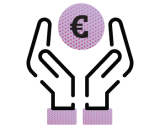Costs of pension
Pension funds invest in order to achieve the highest possible return within set risk limits. However, to achieve the highest possible return, costs must be incurred, such as transaction and management costs. In addition, conducting the pension administration is of course not free of charge. There is a lot of uncertainty about the costs of pension funds, and therefore also about the costs of Philips Pensioenfonds. What costs does the Fund actually incur? And how do the costs relate to the returns on the investments? Valid questions to which Philips Pensioenfonds answers below.
What happens with your pension premium?
Of every euro that is deposited as pension premium for your pension, the vast majority goes to your pension accrual. Because pension funds arrange a pension for many people at the same time, costs can remain low. Incidentally, the costs differ per pension fund. That depends, among other things, on the size of the pension fund and the policy choices made. Of every euro in the pension pot, Philips Pensioenfonds annually pays approximately € 0.005 in costs. Despite these low costs, many people believe that a large part of their premium is spent on costs and therefore does not benefit their pension accrual. Pension funds regulate an important component of the future income provision of large groups of people. That is why the interests are high. Costs must be incurred in order to organize this income provision as well as possible. Pension funds do not have a profit motive. So every euro spent by the pension fund must ultimately contribute to a well-organized and reliable retirement provision.
What costs does a pension fund incur?
Controlling costs is important. Moreover, Philips Pensioenfonds wants to be transparent on this subject. Philips Pensioenfonds therefore annually reports on the costs incurred in the annual report. But what kind of costs are we talking about? And what do these costs entail?
To properly arrange the pension provision of participants, the following costs are incurred:
1. costs for management and organization;
2. supervision costs;
3. pension administration costs;
4. asset management costs.
These costs are explained in more detail below.
1. Costs for management and organization
Philips Pensioenfonds is managed by the Board of Trustees. The Board of Trustees is formed by representatives of the employer, the employees and the pensioners. In addition, three independent experts are included in the Board of Trustees as executive directors. The Board of Trustees is headed by an independent chairman.
The executive directors together form the Executive Board of the Fund. The employer, employee and retired members of the Board of Trustees do not receive a salary for their work at Philips Pensioenfonds.
- The employer members in the Board of Trustees carry out the work for Philips Pensioenfonds as part of their position at one of the affiliated employers.
- For the employee members of the Board of Trustees, the time they work for the Pension Fund is reimbursed to the employer for which they work.
- The retired members of the Board of Trustees receive a fixed remuneration every quarter for participating in meetings and preparing for them.
- Employee and retired members are reimbursed for travel expenses.
- The independent chairman is not employed by Philips Pensioenfonds. He receives a fixed monthly fee.
- The members of the Executive Board (the Executive Directors) are employed by the Fund and receive a salary.
Philips Pensioenfonds has its own Pension Fund Office. The Pension Fund Office provides, among other things, policy preparation for the Board of Trustees and the Executive Board, but also has important supervisory tasks for the activities that have been outsourced. The costs of the Pension Fund Office consist of salary and organizational costs.
2. Supervision costs
Pension funds are supervised by two supervisory organisations: De Nederlandsche Bank and the Authority for the Financial Markets (AFM). The Dutch pension sector bears part of the costs incurred by these supervisors. In recent years, the legal requirements for pension funds have increased considerably. As a result, the costs of supervising pension funds have also risen.
3. Pension administration costs
Before the pension can be paid out later, it must be accurately determined during the career of our members to which pension they are entitled. Philips Pensioenfonds does this for all approximately 90,000 stakeholders. Accurate records are essential to ensure that each participant receives what he or she is entitled to upon retirement. Pension funds are therefore required by law to have their pension administration in order and to meet strict requirements. It is also important to inform participants about their pension, including the choices they can make, and about the ins and outs of the Pension Fund. The pension administration of Philips Pensioenfonds has been outsourced. The Fund pays a fee for this. The amount of this fee generally depends on, among other things, the size of the Pension Fund. But the level of service and the degree and intensity of communication to members can also influence the cost level.
4. Asset management costs
The amount of the pensions is largely dependent on investment income. On average, the participant receives up to four times as much pension as was paid in for him or her. Investing the pension premium is therefore very important. As with Philips Pensioenfonds, one or more external asset managers are often used.
Investing the pension money entails costs. This includes fee for the asset manager and transaction costs, but also costs for supervision, management and organization related to investments. The amount of the costs depends on the amount of assets to be managed. Philips Pensioenfonds has total assets of approximately €16 billion (end of October 2023). Pension funds present the costs of asset management as a percentage of the total invested capital. But what influences the level of this percentage?
- Policy choices of the pension fund: the degree to which a pension fund is willing to take risks and the associated investment mix influences the level of fee paid to an asset manager. Investing in government bonds is generally less expensive than investing in riskier investments such as emerging market equities.
- Active/passive investment: pension funds can opt for active or passive investment. In an actively managed portfolio, the manager tries to outperform a 'sample portfolio', also known as a benchmark. A passively managed portfolio invests exactly according to this benchmark. Active management offers the chance of a higher return than the benchmark, but the costs are generally significantly higher. Philips Pensioenfonds chooses to invest passively for half of the investments The underlying idea is that the benefits of active management most often do not outweigh the higher costs associated with it.
- High return: if an asset manager can realize a high return, then a pension fund is prepared to pay a higher fee for this. An additional 'performance fee' can also be agreed if a certain return is achieved. Philips Pensioenfonds has not agreed a performance fee with the asset manager.
A separate category of costs for investing your pension money are the costs for buying and selling investment instruments, the transaction costs. The more often you buy and sell, the higher the transaction costs. An investment transaction always results from the policy of the Fund.
Asset management: how much does it cost?
Philips Pensioenfonds pays the external asset manager a fixed percentage in management fees. In addition to the management fee, Philips Pensioenfonds pays costs to the asset manager for additional services. Think of administration and advice. In addition, there are costs for supervision, management and organization related to investments. In 2024, asset management costs amounted to 0.31% and transaction costs to 0.12% of average invested capital. The transaction costs are settled with the investment return. The transaction costs have therefore already been deducted from the assets that Philips Pensioenfonds periodically publishes. Philips Pensioenfonds considers it important to measure how the costs of asset management relate to the costs incurred by other pension funds. That is why the Pension Fund regularly participates in a cost measurement carried out by Cost Effectiveness Measurement (CEM). This cost comparison has a worldwide participation of pension funds. The last measurement took place over 2023. The CEM report compares Philips Pensioenfonds with a peer group. The peer group includes Dutch pension funds of comparable size.
Results of the comparison
The Fund's asset management costs over 2023 amounted to 0.32% of the average invested capital, versus the median of the Dutch peer group of 0.37%. The median of all Dutch participants in CEM is also 0.37%. The asset management costs of Philips Pensioenfonds are therefore relatively low. However, this comparison does not take into account differences between pension funds in terms of fund size and investment mix.
CEM has also calculated benchmark costs (using the peer group) that have been corrected for fund size and investment mix. This makes this a realistic cost comparison for Philips Pensioenfonds. Over 2023, the benchmark costs amounted to 0.29%. Philips Pensioenfonds was therefore 0.03 percentage point higher. This is mainly due to the fact that Philips Pensioenfonds incurs higher costs for investing in real estate compared to the Dutch peer group. This is mainly caused by the fact that the Fund not only invests in listed real estate, but also uses real estate funds with the help of real estate managers, which is generally a more expensive implementation style than investing directly or investing in listed securities without a real estate manager.
Pension administration: how much does it cost?
In 2024, Philips Pensioenfonds paid € 149 per pension accrual and pension recipient in pension administration costs. This includes costs incurred by the Fund for the pension administration. But also costs for supervision, management and organization related to pensions.
Related information
Is the information below perhaps also interesting for you?

Why does Philips Pensioenfonds make investments?
For the first part of the series about our investments the question 'Why does Philips Pensioenfonds make investments?' is answered.
Part 1
In which types of investments does Philips Pensioenfonds invest?
For the second part of the series about our investments the question 'In which types of investments does Philips Pensioenfonds invest?' is answered.
Part 2
How does Philips Pensioenfonds determine its investment mix?
For the third and last part of the series about our investments the question 'How does Philips Pensioenfonds determine its investment mix?' is answered.
Part 3